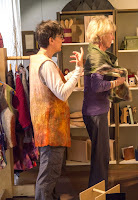When I was 28, I was pretty full of myself. (I heard that; who out there said “. .
.still are.”) I sported a graduate degree from Harvard, had three kids, owned a house, and had been promoted to dept.
head. Once, about that time, I had voiced in our book club doubt
about the capability of ‘ordinary’ citizens to deal with increasingly
complicated problems and choices, like those facing our new President. (Where
were you 53 years ago today?) Oh, I said I believed in democracy . . . but it
was tempting to embrace a politically incorrect elitism.
So it seemed to me only right and proper that I was elected foreman of a Hennepin
County jury sitting in judgment of a very unsavory character who had led an
abduction and gang rape. Ten of my fellow jurists were blue collar men, housewives,
and retirees; only a couple of them might have had any college.
But a few of them firmly scotched someone’s
request to take a test vote right away.
We began to examine the case logically.
Had a crime been committed? If
so, was it believable that the defendant, the first of eight, was, as claimed, unaware of it? If he was aware, was he involved, did he
intercede, did he incite? What
constituted guilt? What was reasonable
doubt?
As discussion proceeded, my fellow jurists revealed
diligence and thoughtful, logical and clear reasoning. Finally, we came down to a lone hold out. Later,
when she suddenly “gave in” and we questioned why, she said she was worried
about catching the last bus to NE Minneapolis.
The group rejected her vote, four of us offered to drive her home, and we
started over. We spent another 90
minutes going back over the logic train; at 12:30am, she finally, and
genuinely, bought it.
That experience changed (I just typo-ed “shamed” which is
probably a better word) my snotty temptation to deprecate the ability of ‘ordinary’
people to fulfill the responsibilities of citizenship. My fellow jurors were patient, thoughtful,
reasonable, logical and determined to do right. They exercised wisdom, regardless of education
or social status.
Many of them might have been Trump voters were they still
around, as am I, more than half a century later. They
might well have been conflicted about the changing color of America, but they aren’t
racist. They likely would be anxious about a
chaotic and dangerous world. They would likely be very uncomfortable with the pace of change. They
undoubtedly would agree that America is on the wrong track – mainly at the hands of elite,
highly-educated professionals, lawyers, bankers and business people – like me. And, what we types didn’t realize, they were
ready to act out Howard Beale’s howl, “I'm as mad as hell, and I'm not going to take
this anymore!" Paddy Chayefsky
forewarned us in 1976, as did Richard Rorty in 1998 (which my friend David S. brought to my attention,) and still others more recently. But we didn’t listen; we didn’t get out there to
see and hear.
Trump voters generally and in certain key states, overwhelmingly,
expressed their judgment that the elitist leadership of the last couple of
decades deserve to be tossed aside, even at the risk of not knowing what may
replace them. Put aside that the voters
may have been conned, as I think they have, but attend to their judgment that something new
must be forged. That is their judgment, perhaps even their wisdom.
Rather than carp about Trump’s fearsome petulance, his inanities
and lies, about his unsuitability to preside, we had better focus our energies
on listening and responding to address concerns and reassure that we are hearing our fellow citizens – for we
have been indicted and they are the jurists sitting on our case. And I trust them, in the end, to do what's
right.










